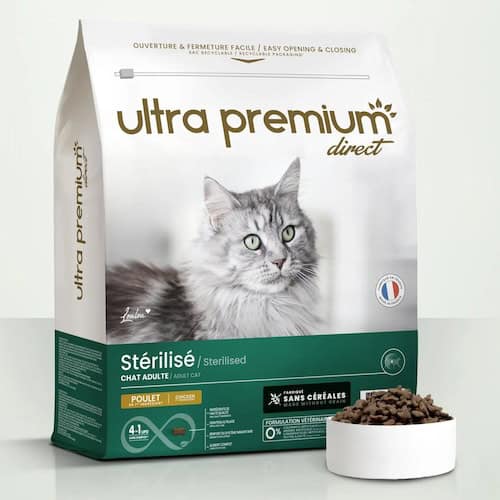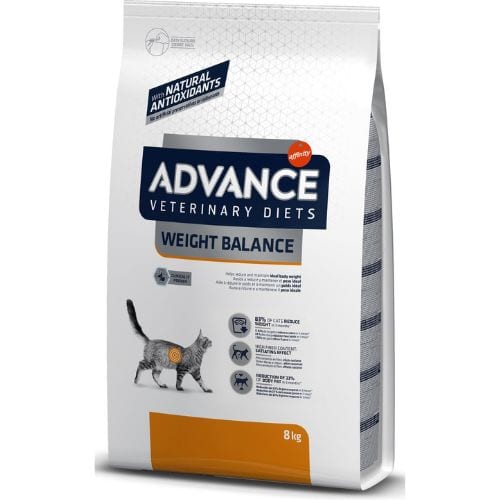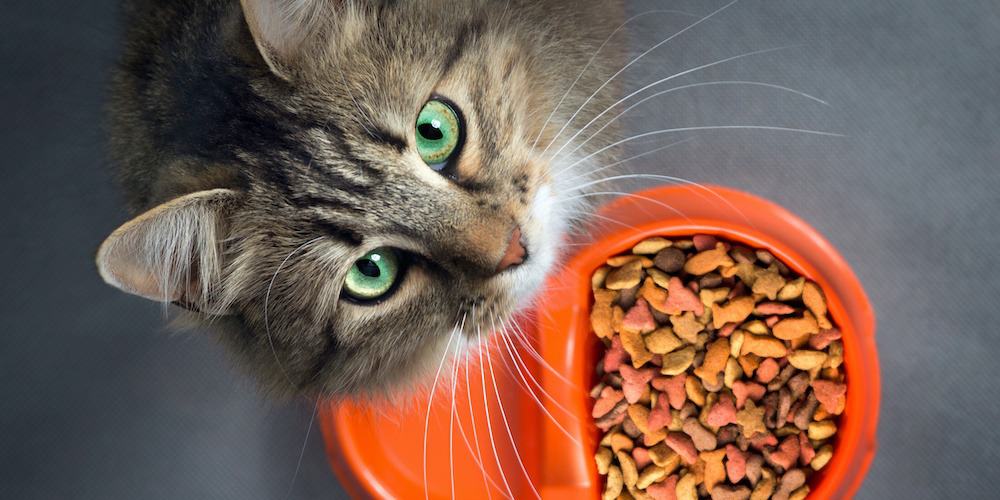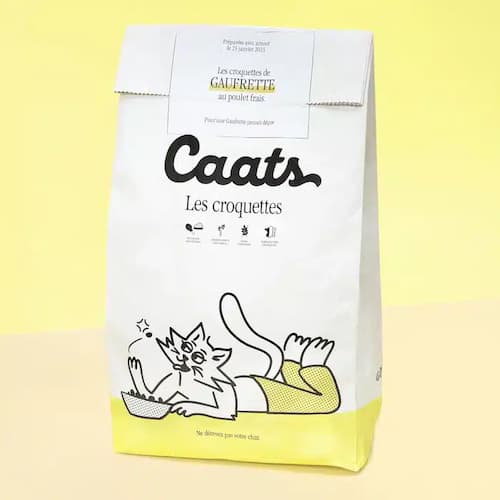Summary of my selection
Meilleures Croquettes pour Chat 2025 🥇
> Croquettes personnalisées pour chaque profil : chaton, stérilisé, senior – Caats
⏱️ Ongoing offer: 50% off the trial kit
Best value
> Kibble for spayed/neutered or indoor adult cats – Ultra Premium
Best premium cat kibble
> Kibble for neutered cats – Franklin
The importance of nutrition for health is well established. When combined with a satisfactory lifestyle, it ensures a long and healthy life for both humans and cats. For a long time, commercial pet foods, and particularly kibble, have been favored by pet owners.
Convenient, complete, safe (notably due to their cooking and low moisture content), anti-tartar, cat kibble indeed has many advantages. Added to that is their crunch, which many animals love.
But in recent years, brands have multiplied, boasting their merits with large pictures of chicken fillets or fresh peas printed on flashy packaging. Oh yes, 15 million cats in France — that stirs desire…
From then on, it’s difficult for the average person to make the right choice. Because marketing is fine, but for Réglisse or Plume, a good RPP (Protido-Phosphoric Ratio — see below in the article) is better!
Brands tested and compared : Advance (Affinity), Brekkies (Affinity), Caats, Edgar Cooper, Eukanuba (Spectrumbrands), Franklin, Hill’s, Iams (Spectrumbrands), Lifelong (Amazon), Nature’s Variety (Affinity), Orijen (Mars), Purina One (Nestlé), Purina Pro Plan (Nestlé), Ultra Premium, Virbac, Wellness Core, Whiskas (Mars), Ziggy.
We evaluate all products independently. If you click on one of the links provided, a commission may be paid to us, without affecting the price or the ranking.
A small feline, very carnivorous…
Cats have specific nutritional needs. First, they are strict carnivores, unlike dogs, which are more omnivorous. That doesn’t mean they eat only meat, but that proteins (especially animal-derived proteins, i.e., from meat, fish, or eggs) must make up a predominant part of their diet.
They also have particular needs for certain amino acids (the building blocks of proteins) such as taurine, which is absent from plant proteins. In addition, cats have weak points: their kidneys and urinary system, which must be protected.
… and prone to being overweight
In France, the vast majority of male cats are neutered and females are spayed. However, this sterilization is not without consequences for the body’s metabolism: appetite increases and fat accumulates. Our sterilized cats are predisposed to becoming overweight.
This, if left unchecked and especially if the animal is sedentary, can lead to obesity. As in humans, excess weight promotes the onset of many conditions such as diabetes, osteoarthritis, hepatic lipidosis… It is estimated that the energy requirements of a sterilized cat are reduced by about 20% compared to an intact animal. This should be taken into account when formulating dry foods intended for this feline population.
How to find the right kibble? The one that best meets the needs of a sterilized cat? To navigate the jungle of the pet food market, with Darwin Nutrition I present this comparison of a sample of 19 brands. This article will also offer tips for spotting the best kibble by decoding the labels.
Best cat kibble: our review
With Darwin Nutrition, we produced a ranking of the 19 kibbles studied. Here is the ranking, overall and according to a few specific criteria.
This is a ranking based on objective criteria, according to current knowledge of feline nutrition, but of course it only applies to the kibbles selected for this comparison. Other foods not studied here are certainly excellent products.
Note: Prices are provided for informational purposes only; they may vary from site to site and depending on promotions.
# Best Cat Kibble 2025 🥇
Caats – Customized kibble
Advantages
- Percentage, protein origin, RPP and RPC are top-notch
- Customizable almost infinitely
- Made in Vendée
- Can view the kibble composition before ordering
Disadvantages
- A slightly high fat content (15%)
- The price of a premium kibble (discount applies starting at 2 cats)
Launched by veterinarian Jean-Marc Denoun, Caats is a small brand that is expanding by tapping into the custom-made trend.
To evaluate Caats, I created the profile for “Riton”, a 6-year-old neutered male cat; I then completed a questionnaire about his age, breed, body condition, physical activity (none!) and health issues (arthritis, kidney failure, urinary stones, digestive problems, allergies…).
I immediately had access to the characteristics of the kibble recommended for Riton, and it was all good (41% protein, 21.5% carbohydrates, 8% ash, and 4.5% fiber). One more click and you get his trial kit.
Subscription option so you don’t have to think about it anymore, a real bonus for an overbooked human. Warning: if your companion has a chronic illness, their personalized kibble does not replace a veterinary consultation.
A responsive brand. Sometimes a little too responsive. If you’re allergic to pushy marketing, move on. Founded in 2020, Caats already has 79,000 followers and has earned a ‘good’ online rating.
Price: €29.70 for a 3 kg bag
# Best value for money
Ultra premium direct – Grain-Free Kibble for Sterilized or Indoor Adult Cats

Rating: 4.4/5
Nutrition: ★★★★☆
Safety: ★★★★☆
Brand: ★★★★★
Advantages
- Proteins OK
- Best-rated brand
- No middleman to reduce costs
- Made in Lot-et-Garonne
Disadvantages
- A slightly low fiber content for a light kibble (2%)
- Non-veterinary brand
You won’t hear anything bad from Ultra Premium Direct’s 183,000 followers, since they gave it a rating of 4.7/5!
With a more-than-decent formula, this kibble offers the best value for money in our panel (€9.60 per kilogram when ordering from the brand’s website, €8.66 with a subscription in 2024). A worthwhile compromise for tight budgets in these times of inflation.
Ultra Premium Direct kibble contains 43% protein, 23% carbohydrates, and 15% fat. They are produced in France from ingredients originating in the European Union. The brand is a member of FACCO, which guarantees compliance with animal feed regulations.
And for those allergic to ordering online, Ultra Premium has also opened stores in several cities across France; the most recent one has just opened in Normandy (Hérouville).
Price: €28.90 for a 3 kg bag
# Best premium cat kibble
Franklin – Grain-free cat kibble

Rating: 4.4/5
Nutrition: ★★★★☆
Safety: ★★★★☆
Brand: ★★★★★
🎁 Promo code -30% + free shipping: DARWIN30
Advantages
- Good nutrition rating
- Excellent value for money
- Low in calories
- A French brand
Disadvantages
- Not the highest RPP in the comparison
- Made in the EU, not France
Franklin is a small, fast-growing brand (22,000 followers already!). Founded only in 2018 by two cat and dog lovers, the company is based in Paris. They are among the pioneers of single-protein kibble for the most sensitive cats. It offers excellent value for money with high-quality products at a reasonable price.
The kibbles we selected are made from chicken and salmon proteins (70% of the ingredients). They are among the least rich in the range, with a fat content of 11% and 355 kcal / 100 g. They also contain omega-3 fatty acids for the heart and skin, vitamins and minerals.
Franklin’s kibble is manufactured in the Czech Republic. The brand is rated 4.7/5 on Truspilot, which shows real customer satisfaction. There is also a very responsive customer service (email reply within half a day!).
Price: €31.90 for the 3 kg bag
# Best veterinary-brand kibble for sterilized cats
Virbac HPM – Adult sterilized cat kibble

Rating: 4.5/5
Nutrition: ★★★★★
Safety: ★★★★★
Brand: ★★★★☆
Advantages
- 44% protein, 90% of animal origin (pork and poultry)
- A recognized French veterinary brand
- Feline health results backed by scientific studies, with 36 supporting publications
- High in fiber
Disadvantages
- Packaging in English that doesn’t really appeal
- The price of the (very) high-end kibble
Proudly French! It’s yet another French kibble (made in the Camargue) that stands out! The HPM range (for Hyper-Premium) is developed by veterinary nutritionists and comes with all the guarantees of a veterinary brand. The Virbac group, founded in 1968 by Pierre-Richard Dick, is a heavyweight in animal health with ranges of medicines, hygiene products, and pet foods.
Well-balanced kibble, low in carbohydrates (20.5%) and high in fiber (8%) for better digestive comfort and greater satiety; a high fiber content that should not come at the expense of stool quality (possible in some sensitive animals).
Virbac HPM kibble suffers from a slight lack of notoriety (5282 followers); they can be found in veterinary clinics or on those clinics’ websites and in pet stores. A technical kibble to discover, offering veterinary quality and safety with the same standards as human food. Buy it with your eyes closed!
Price: €35.95 for a 1.5 kg bag
# Best kibble for overweight cats
Advance – Veterinary diets, Weight balance

Rating: 4.1/5
Nutrition: ★★★★☆
Safety: ★★★★★
Brand: ★★★☆☆
Advantages
- The least calorie-dense in the panel
- Clinically tested for weight reduction
- High fiber content
- A good protein profile
Disadvantages
- Corn as the main ingredient
- A somewhat cluttered brand website
With a good protein content (43%) and controlled fat (9%) and carbohydrate (26%) levels, the lightest kibble in the panel (329 kcal per 100 g) is Spanish.
Advance Veterinary Diets is indeed the veterinary range of the Spanish brand Affinity, which challenges the giants Nestlé and Mars. The Weight Balance kibbles promise to help overweight animals lose weight (provided the portions are followed). They also help maintain ideal body weight.
One drawback: it’s disappointing that corn is the primary ingredient in this light recipe, just ahead of poultry.
Advance products are manufactured in Spain and available online and in garden centers (not all of them are “veterinary diets”). Regarding safety, the brand is affiliated with FACCO.
Price: €32.99 for a 3 kg bag
Methodology
Darwin Nutrition selected 19 kibbles for sterilized cats among the best-selling online. This is of course not an exhaustive list, but a representative sample of the dry foods most consumed by our feline friends. Each was given an overall score including: a nutritional score, a food safety score, a brand score. I personally handled the first two. Darwin Nutrition handled the brand score based on reputation, transparency, and customer satisfaction via online reviews.
The information was collected from the manufacturer’s website. When it was not available, an email was sent to customer service. If that email went unanswered, one or more phone calls were made.
Unfortunately, some brands did not play the transparency game, failing to provide important information regarding the quality of their sterilized cat kibble, such as phosphate levels, for example. They were of course penalized in their rating.
→ Access my full comparison table here (Google Sheet)
1. Nutritional quality rating
As the cat is an obligate carnivore, I paid particular attention to the quantity and quality of proteins. Next came the mineral levels, which must be controlled to avoid urinary stones and kidney problems. For kibble intended for sterilized cats, I also looked for moderate levels of carbohydrates and fat to prevent weight gain, and a satisfactory fiber content for the satiating effect.
However, it should be kept in mind that the sum of all nutrients must equal 100%; that is, if one component is drastically reduced, such as fat, this statistically raises the others, such as carbohydrate levels. The composition of kibble for sterilized cats is therefore also a matter of compromise.
Proteins
For proteins, I gave a score out of 5. It took into account the main ingredient, which should be animal protein (fish or meat); it’s still unfortunate for a small carnivorous feline to find products whose first ingredient is a grain.
I then looked at the total percentage of protein, which should be above 35%. However, this percentage is not sufficient because it does not indicate the quality of the proteins or the amount actually consumed by the animal. For that, I used two tools:
The RPP or Protein-to-Phosphorus Ratio : it is the percentage of protein divided by the percentage of phosphorus contained in the kibble. It provides an indication of protein quality, and notably of an excessive presence of bone and cartilage. An RPP >35 is sought.
The RPC or Protein-to-Calorie Ratio : it is calculated by dividing the percentage of protein by the energy density of the food. The RPC gives an estimate of the amount of protein ingested, which also depends on the amount of kibble actually eaten, and therefore on the energy density of the food. For a neutered cat, the RPC should be greater than 87, or even 105 if the cat is also sedentary (indoor cat).
And that’s kind of where the problem lies, because phosphorus and energy levels (not mandatory on labels) have not always been easy to obtain… Some major brands (see table) among the best-sellers obstructed the disclosure of this crucial information for judging the quality of a cat kibble, which is neither fair to the customer nor reassuring for cats…
Minerals or crude ash
For a long time, kibble had a bad reputation, blamed for promoting the occurrence of urinary problems in cats. This was due to high and unbalanced mineral contents. It seems the lesson has been learned, as none of the products exceeded 10% crude ash.
In detail, I paid particular attention to the phosphorus level when it was available. Phosphorus is indeed singled out for harmful effects on cats’ kidney health. Its level should not exceed 1.1%. The minimum level is around 0.7%, and 1% for calcium. The Calcium/Phosphorus ratio should be greater than 1.
Fats, carbohydrates and energy
These nutrients provide energy. In excess, they promote hyperglycemia (sugars) and weight gain. For kibble for spayed/neutered cats, a fat content of 9 to 12% and a carbohydrate content not exceeding 25 to 30% are generally recommended.
I did not favor the ‘no grain’ or grain-free approach, which is more of a trend than a real nutritional issue. Overall, cats digest starch well (necessary for kibble texture and energy supply). In grain-free kibbles, corn, rice, or wheat are replaced by legumes (peas) which also provide starch and are not more digestible. Peas have even been suspected in some studies of being cardiotoxic in dogs. There is currently no data indicating the same for cats.
Fibers (or crude fiber), for their part, are important for digestive transit and also help to calm the feeling of hunger. One final important point for animals prone to gaining weight and whose portions often need to be restricted. But be careful: in too large quantities, fibers can cause digestive irritation. The recommended content is between 1 and 5%, up to 8-9% for kibble for spayed/neutered cats.
Energy in kcal reflects the caloric content per 100 g of kibble; it should be adjusted for spayed/neutered cats, who are often prone to weight gain.
The nutritional analysis allowed a score out of 10 to be assigned to each product.
2. Food safety rating
This point was scored out of 5. It took into account the place of production (production in Europe is better, in France even better, for food safety and for the planet).
I also looked at the pet food manufacturer’s membership in FACCO. Members of FACCO commit to complying with the regulations in force in the European Union.
None of the kibble was organic. An unfortunate fact, but likely related to the cost of organic raw materials.
Finally, the score was increased for veterinary sterilized cat kibble. These products are the only ones that guarantee regular quality controls and provide clinical studies demonstrating the beneficial effects of their foods on feline health.
3. Brand rating
Darwin Nutrition handled this part, taking into account reputation (number of followers) and the brand’s longevity.
Customer satisfaction (here the owner), as reflected by online reviews (if available), is a good indicator of the food’s palatability. However, for sterilized cat kibble, excessive palatability can lead to overeating, resulting in overweight or even obesity. While flavor is important, the food does not necessarily have to be “too good” (and often too fatty, because it is the fats that largely make food palatable).
The transparency of the cat kibble brand (comprehensive website, promptness in responses…) was also taken into account.
The sum of these 3 scores produced an overall score out of 20, converted to an overall score out of 5.
Full comparison
| (note sur 5) | Note globale | Note Nutrition | Note Sécurité | Note Marque | |
|---|---|---|---|---|---|
| #1 | Caats 🥇 | 4.5 | 5 | 4 | 5 |
| #2 | Ziggy | 4.5 | 5 | 4 | 5 |
| #3 | Virbac | 4.5 | 5 | 5 | 4 |
| #4 | Franklin | 4.4 | 4 | 4 | 5 |
| #5 | Ultra Premium | 4.4 | 4 | 4 | 5 |
| #6 | Hill’s | 4.2 | 5 | 5 | 3 |
| #7 | Advance | 4.1 | 4 | 5 | 3 |
| #8 | Edgar Cooper | 3.9 | 3 | 4 | 5 |
| #9 | Orijen | 3.8 | 4 | 3 | 4 |
| #10 | Purina Pro Plan | 3.6 | 5 | 3 | 3 |
| #11 | Hill’s | 3.6 | 3 | 5 | 3 |
| #12 | Iams | 3.0 | 2 | 4 | 3 |
| #13 | Eukanuba | 2.9 | 2 | 4 | 3 |
| #14 | Whiskas | 2.0 | 2 | 3 | 1 |
| #15 | Nature’s Variety | 1.9 | 2 | 2 | 2 |
| #16 | Purina One | 1.9 | 2 | 2 | 2 |
| #17 | Wellness Core | 1.7 | 2 | 1 | 2 |
| #18 | Lifelong | 1.5 | 2 | 2 | 1 |
| #19 | Brekkies | 1.3 | 1 | 1 | 2 |
→ Access my full comparison sheet here (Google Sheet)
Frequently Asked Questions (FAQ)
How much kibble should I give my cat per day?
The exact amount of food to provide depends on several factors: the cat’s age, reproductive status (neutered/intact), breed, activity level, body condition, and the product’s energy density… Unless you’re an expert nutritionist comfortable with the calculations, it’s hard to make sense of it. It’s best to trust the brand; it usually indicates the amount of kibble to feed based on the cat’s weight. This may be a precise amount for personalized kibble or a range. In that case, I recommend aiming for the average dose for a cat of normal weight, and the minimum amount for an overweight cat.
However, a cat on a diet can become very… cranky. To stave off hunger, it’s advisable to give them several small meals per day. You should also choose a low-calorie kibble, possibly mixed with wet food (because it’s full of water, it fills the stomach better).
Why does my cat vomit its kibble?
Regurgitation of kibble within minutes after a meal (preferably on the bed or the rug!) is a classic feline behavior! This can simply be a sign of an overly greedy cat. To remedy the problem, it is recommended to split the amount of kibble throughout the day. There are very handy kibble dispensers for that. Mild gastritis (stomach irritation from hair or catnip, for example) can also cause vomiting of undigested food from the bowl. Food intolerances can also play a role.
If the problem persists or is accompanied by diarrhea, weight loss, or a decline in general condition, you should of course consult a veterinarian.
What to give my cat when I run out of kibble?
Ah… It’s best to plan ahead so you don’t run out of your pet’s usual food. Indeed, sudden dietary changes can cause digestive issues (diarrhea). That said, you’re not going to let a cat starve. While you wait to restock your usual kibble, you can get supplies from a veterinary clinic (best) or from a supermarket or corner shop. The products found there are of lower quality but can be helpful for a few days. In addition, this little carnivore can also eat chicken, ground beef, or tuna… mixed with a spoonful of well-cooked rice, a few slices of carrot, or some green beans.
Why has my cat stopped eating its kibble?
Various reasons can lead to a dislike of the usual kibble:
· Anorexia (loss of appetite) related to illness
· Dental problems
· A spoiled bag (rare, but it can happen) or one that has been opened for too long
· A very picky cat (it does that to you regularly)
If, in addition to neglecting its kibble, your cat seems lethargic or shows worrying symptoms, don’t delay consulting a veterinarian.
To avoid altering their flavor and quality, it is recommended to keep the kibble in a cool, dry place. You should also close the bag well with a clothespin or the zipper provided for that purpose. Transferring the kibble into a metal or plastic container can also give it a taste the cat may not appreciate.
Should you buy grain-free kibble?
Yes, and no…
‘No grain’, ‘grain-free’ — this new concept taking the pet-food world by storm — is it really justified? If it’s true that ‘in the wild’ a cat doesn’t eat corn, wheat, or rice, it doesn’t ingest more potatoes, peas, or lentils either — ingredients that replace grains in kibble by providing their starch.
There is no need to throw your grain-containing kibble away, especially if it has suited your companion for many years. However, the ‘no grain’ options appearing on the market seem to be an acceptable alternative.
You should always keep in mind that every cat is unique. Apart from decisive nutritional issues (or a blatant lack of transparency from the brand), the right food for your furry companion is the one they like, that doesn’t make them gain weight and… gives them healthy stools (a sign of good nutrient absorption).
Should you give your cat kibble or wet food?
Nowadays, the trend is to mix dry and wet food for cats for several reasons:
· An all-kibble diet can, for some felines, cause a hydration deficit responsible for the formation of urinary crystals or stones. In fact, some animals do not drink enough to compensate for the low water content of kibble. Water fountains can be a good way to encourage these cats to drink. Providing wet pâtés, meatballs or mousse soaked in water (about 75% versus 10% for kibble) is also a solution.
· Thanks to its high water content, wet food can also be beneficial in cases of chronic constipation.
· Lower in calories and more satiating, it helps combat overweight and obesity.
It is therefore possible to serve wet food once or twice a day and supplement with kibble that the cat can nibble on throughout the day.
When to switch to kibble for neutered cats?
In France, animals are generally sterilized at around 6 months of age. This procedure has many beneficial effects (reduced mammary tumors in female cats, fewer fights and a lower risk of contracting FIV in male cats…). However, it can, combined with a certain lack of activity, lead to excessive weight gain. Since prevention is better than cure, it is recommended to start feeding neutered-cat kibble just after castration or ovariectomy. Some brands offer kibble for neutered kittens; these are useful for cats with a longer growth period, such as the Maine Coon.
When changing foods, you should transition from kitten food to food for neutered cats. You only need to gradually incorporate the new kibble into the ration.
And for a long, healthy life, avoid junk food, as we humans do, and favor the best kibble for neutered cats.
Bibliography
1. https://europeanpetfood.org/self-regulation/nutritional-guidelines/
2. https://pubmed.ncbi.nlm.nih.gov/29623690/
3. https://onlinelibrary.wiley.com/doi/full/10.1111/jvim.15961
5. http://www.facmv.ulg.ac.be/amv/articles/2001_145_4_03.pdf
5. Blog of veterinary nutritionist Dr. Géraldine Blanchard
6. Blog of veterinary nutritionist Dr. Charlotte Devaux




